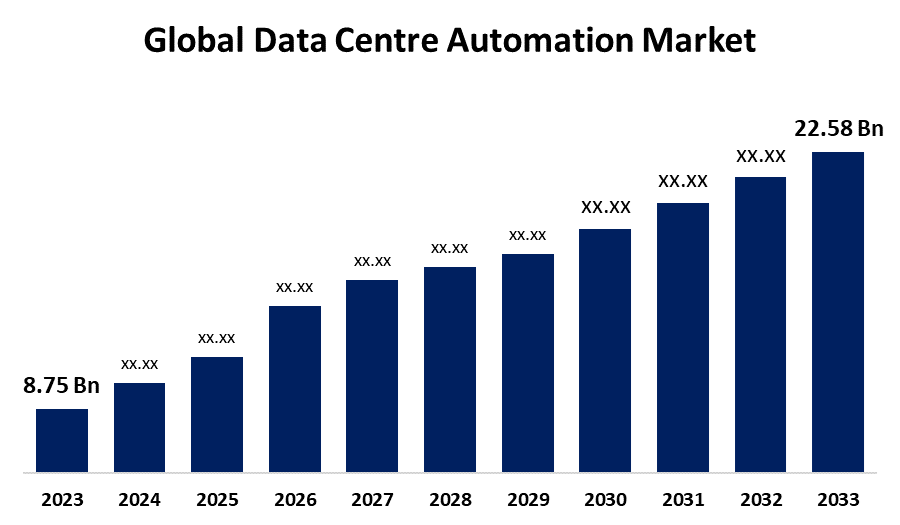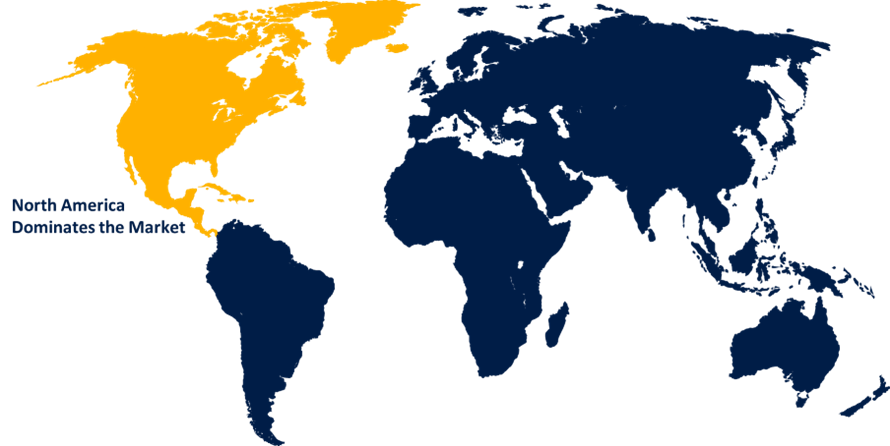Global Data Center Automation Market Size, Share & Industry Analysis, By Data Center Type (Enterprise or On-premise, Colocation or Managed, Public Cloud), By Component (Solutions and Services), By End-user (BFSI, Retail & E-Commerce, IT and Telecommunications, Government & Public Sector, Energy & Utilities, Manufacturing, Healthcare, Others), and By Region (North America, Europe, Asia-Pacific, Latin America, Middle East, and Africa), Analysis and Forecast 2023 - 2033
Industry: Information & TechnologyData Center Automation Market Insights Forecasts to 2033
- The Global Data Center Automation Market Size was Valued at USD 8.75 Billion in 2023
- The Market Size is Growing at a CAGR of 9.94% from 2023 to 2033
- The Worldwide Data Center Automation Market Size is Expected to Reach USD 22.58 Billion by 2033
- Asia Pacific is Expected to Grow at the fastest CAGR during the forecast period.

Get more details on this report -
The Global Data Center Automation Market Size is Anticipated to Exceed USD 22.58 Billion by 2033, Growing at a CAGR of 9.94% from 2023 to 2033.
Market Overview
The method by which regular workflows and procedures in a data center such as application delivery, scheduling, monitoring, and maintenance are managed and carried out without the need for human administration is known as data center automation. The growth of the market is driven by the increasing positioning of 5G networking technologies and the popularity of hybrid cloud architectures. As businesses spend more money on establishing a reliable data center infrastructure, the demand for data center automation is rising. The pandemic significantly impacted the desire for automated solutions. Due to the pandemic and other health and safety issues, companies have adopted data automation for production. People became more concerned about their privacy and security, which led to a surge in the automation industry. The digitization of healthcare data, for instance, has significantly expanded its volume and portability. The growing use of digital Electronic Health Records (EHRs) and online prescriptions tends to increase storage demands among healthcare providers, prompting them to invest in data centers. In December 2022, NTT Data carried out a reportedly successful trial involving a robot within a data center and planned to implement it across its 15 facilities in Japan while also preparing to bring the service to the commercial market. The organization introduced a robot designed with a wheeled torso, complete with arms and basic grippers, along with a range of sensors for tasks related to remote monitoring & inspection. These robots provide proactive maintenance and can respond to incidents promptly, ensuring data center uptime and optimizing operational costs, making them a promising solution in the industry.
Report Coverage
This research report categorizes the data center automation market based on various segments and regions forecasts revenue growth and analyzes trends in each submarket. The report analyses the key growth drivers, opportunities, and challenges influencing the data center automation market. Recent market developments and competitive strategies such as expansion, type launch, development, partnership, merger, and acquisition have been included to draw the competitive landscape in the market. The report strategically identifies and profiles the key market players and analyses their core competencies in each sub-segment of the data center automation market.
Global Data Centre Automation Market Report Coverage
| Report Coverage | Details |
|---|---|
| Base Year: | 2023 |
| Market Size in 2023: | USD 8.75 Billion |
| Forecast Period: | 2023-2033 |
| Forecast Period CAGR 2023-2033 : | 9.94% |
| 2033 Value Projection: | USD 22.58 Billion |
| Historical Data for: | 2019-2022 |
| No. of Pages: | 230 |
| Tables, Charts & Figures: | 120 |
| Segments covered: | By Data Center Type, By End-user, By Region, COVID-19 Empact, Challenges, Future, Growth, & Analysis |
| Companies covered:: | Microsoft Corporation, Cisco Systems, Inc., ABB, Dell Corporation, Oracle, VMWare, Hewlett Packard Enterprise Development LP, BMC software, Inc., Citrix Systems, Inc., ServiceNow, FUJISTU, International Business Machine (IBM), SAP SE, Red Hat Inc, and Other Key Vendors |
| Pitfalls & Challenges: | COVID-19 Empact, Challenges, Future, Growth, & Analysis |
Get more details on this report -
Driving Factors
The demand for processing power, more storage space, and sophisticated networking has grown significantly due to the growing use of the internet and networking on a global scale. The rapid advancement in technology transforming data centers, such as server virtualization, is expected to drive the market. Many managed service providers (MSPs) and data centers are migrating to Software Defined Data Centers to reduce infrastructure burdens (SDDCs). Vitualization technologies recreate computing power and storage in software form in an SDDC model. In contrast to the traditional, inefficient method of issuing one server to each user, server virtualization enables data centers and service providers to house multiple users on a single server by segmenting servers. This expansion has also enhanced the complication of networking, integration, and resource pooling in data centers. These factors are critical to the growth of the global data center automation market.
Restraining Factors
Currently, the most significant obstacle facing the data center automation market is the requirement for new technologies to be effectively integrated with legacy systems that already exist. Data centers are faced with the challenge of integrating state of the art automation tools and software with older infrastructure and systems that were not intended for extensive integration as they look to automate more processes. Deploying comprehensive automation strategies may encounter challenges in achieving seamless interoperability between new and old within these complex environments.
Market Segmentation
The data center automation market share is classified into data center type, component, and end-user.
- The enterprise or on-premise segment is estimated to hold the largest market share through the projected period.
Based on the data center type, the global data center automation market is classified into enterprise or on-premise, colocation or managed, public cloud. Among these, the enterprise or on-premise segment is estimated to hold the largest market share through the projected period. The reason for this dominance is the reluctance of data centers to fully adopt public cloud-based infrastructure for mission-critical operations. Many organizations would rather maintain direct physical control and governance over systems that carry out crucial tasks like automation, which synchronizes actions among hardware, software, networks, and other operational components.
- The solutions segment is estimated to hold the largest market share through the projected period.
Based on the component, the global data center automation market is classified into solutions and services. Among these, the solutions segment is estimated to hold the largest market share through the projected period. The segmental growth can be attributed due the mobility, expandability, and adaptability of automation solutions, data centers operate efficiently, providing a robust control panel for completely automated, and remote data center management.
- The IT and telecommunications segment is estimated to hold the largest market share through the projected period.
Based on the end-user, the global data center automation market is classified into BFSI, retail & e-commerce, IT and telecommunications, government & public sector, energy & utilities, manufacturing, healthcare, others. Among these, the IT and telecommunications segment is estimated to hold the largest market share through the projected period. This is mostly because of the rise in demand for high-speed data services and the development of mobile technologies.The growth of the information technology and telecommunications sectors benefited the economy by creating new jobs and business opportunities. Prices for customers have dropped as a result of heightened rivalry among service providers.
Regional Segment Analysis of the Data Center Automation Market
- North America (U.S., Canada, Mexico)
- Europe (Germany, France, U.K., Italy, Spain, Rest of Europe)
- Asia-Pacific (China, Japan, India, Rest of APAC)
- South America (Brazil and the Rest of South America)
- The Middle East and Africa (UAE, South Africa, Rest of MEA)
North America is anticipated to hold the largest share of the data center automation market over the predicted timeframe.

Get more details on this report -
North America is anticipated to hold the largest share of the data center automation market over the predicted timeframe. The data center automation market is being driven by numerous organizations that are adopting cloud computing solutions at an increasing rate. As a result, a lot of the region's market players are investing more in cloud computing services. Businesses are even more committed to offering services for data center automation.
Asia Pacific is expected to grow at the fastest CAGR growth in the data center automation market during the forecast period. The Asia-Pacific data center automation market has significant growth potential due to the region's abundance of small and medium-sized enterprises and their growing use of cloud computing. In addition, a large number of small and medium-sized businesses and their increasing adoption of cloud computing create lucrative growth potential for the Asia-Pacific data center automation market.
Competitive Analysis:
The report offers the appropriate analysis of the key organizations/companies involved within the data center automation market along with a comparative evaluation primarily based on their type of offering, business overviews, geographic presence, enterprise strategies, segment market share, and SWOT analysis. The report also provides an elaborative analysis focusing on the current news and developments of the companies, which includes type development, innovations, joint ventures, partnerships, mergers & acquisitions, strategic alliances, and others. This allows for the evaluation of the overall competition within the market.
List of Key Companies
- Microsoft Corporation
- Cisco Systems, Inc.
- ABB
- Dell Corporation
- Oracle
- VMWare
- Hewlett Packard Enterprise Development LP
- BMC software, Inc.
- Citrix Systems, Inc.
- ServiceNow
- FUJISTU
- International Business Machine (IBM)
- SAP SE
- Red Hat Inc
- Others.
Key Target Audience
- Market Players
- Investors
- End-users
- Government Authorities
- Consulting And Research Firm
- Venture capitalists
- Value-Added Resellers (VARs)
Recent Developments
- In March 2023, Digital Reality introduced a robotic canine for routine inspections. The company reported that this machine conducted approximately nine inspections missions each day, following a scheduled managed through the Anymal API. During its two-hour mission, it monitored around 70 elements, capturing visual, thermal, and acoustic data. After completing a mission cycle, the robot autonomously returned to its docking station for recharging.
- In October 2022, Cisco invested in a dedicated India Webex infrastructure to accelerate Webex adoption, which included a new data center and the necessary regulatory licenses.
Market Segment
This study forecasts revenue at global, regional, and country levels from 2023 to 2033. Spherical Insights has segmented the data center automation market based on the below-mentioned segments
Global Data Center Automation Market, By Data Center Type
- Enterprise or On-premise
- Colocation or Managed
- Public Cloud
Global Data Center Automation Market, By Component
- Solutions
- Services
Global Data Center Automation Market, By End-User
- BFSI, Retail & E-Commerce
- IT and Telecommunications
- Government & Public sector
- Energy & Utilities
- Manufacturing
- Healthcare
- Others
Global Data Center Automation Market, By Regional Analysis
- North America
- US
- Canada
- Mexico
- Europe
- Germany
- UK
- France
- Italy
- Spain
- Russia
- Rest of Europe
- Asia Pacific
- China
- Japan
- India
- South Korea
- Australia
- Rest of Asia Pacific
- South America
- Brazil
- Argentina
- Rest of South America
- Middle East & Africa
- UAE
- Saudi Arabia
- Qatar
- South Africa
- Rest of the Middle East & Africa
Need help to buy this report?